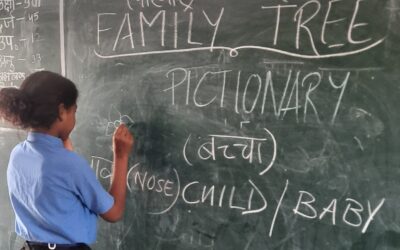There were fewer students in my school that day and I was talking to some of the boys from 10th grade. It is located in the village of Jhed, Rajasthan. They were curious about my age and lifestyle. The conversation led to their understanding of relationships, gender differences and sexual attitudes. I also wanted to know the ways of their tribe better.
Garasia is a tribe that’s settled in the districts of Pali, Sirohi, Dungarpur, Udaipur and a few bordering villages of Gujarat. The legend goes that thousands of years ago, there were four brothers who were liked by all. Yet, only three of them got married. The fourth one just moved in with a girl. Somehow, the other three were unable to produce any child but the fourth one was successful in reproducing and hence, victorious in taking forward the legacy of their Garasia tribe without getting married. Since then, this ritual of living together and having children without getting married, is being followed in the tribe.
For our country, it’s really progressive but ironically they are termed as ‘backward.’ Further, they also practice polygamy where the man with the consent of his first wife and her father, brings in another woman in the house, in agreement with her and her father. This is mostly done for convenience. For example, while one wife takes care of household chores and children, the other can work on fields with her husband. Children from both the wives are aware about their real mother and real siblings.
Their ways of life are unique to me as I haven’t come across anything like this before!
Now, let me tell you something about teenagers.
The boys and girls meet each other in social gatherings, exchange numbers or show interest, plan to meet and go out secretly. They say they fall in love, though sometimes it’s just about ‘thand mitana’ (satisfy lust), as one of young boys points out. He says that a ‘ladki’ (girl) is ‘garam’ (hot) and that most couples do the ‘kaam’ behind bushes or in isolated places. They use the word ‘kaam’ to describe sex. Boys and girls in this community start having intercourse at an early age of 11-13.
Coming back to love, if the couple decides to disclose their relationship to their parents, they convince each other’s families, starting from the girl side. Once the families agree, they all go to her place for an engagement ceremony. Here, alcohol, along with sweets are given as a token of confirmation by the boy’s side of the family. The guy stays at girl’s place for a while before they move in together to start a new phase of life. At this point, there is no binding ritual taking place, like that of a wedding. It’s just two people deciding to live together. Pregnancy before moving-in is also acceptable. Children and marriage have no co-relation here.
As time passes and if both of them realize that they do not want to stay together, they separate without any drama. Children go with their father rather than the mother, as he owns the land & money, and there is a need for successor when he passes away. In case of infidelity from the boy’s side, his family pays certain amount to the girl’s family.
In another case, the boy and girl may decide to get married. Then, the wedding expenses are borne by the boy’s family, and even some dowry is given to the girl’s parents, in cash. Her side spends only a minimal amount of money.
For arranged engagement/marriage, the boy expresses his desire of living with a girl, to his family. Soon, they find a suitable girl and get him engaged/married through the process mentioned above. Again, if they want to end the marriage, nothing extravagant happens. The girl simply leaves and if the boy wants to leave as well, he must reimburse her family with the amount they spent in the wedding. When it comes to sorting out the issues, there is one representative each, from both the sides, who sit together and try to reach a solution. It’s important to know that they are still unaware of contraceptives to stop unwanted pregnancies and STDs, even if they may sound really progressive.
It is intriguing to see so many cultural differences in a state, let alone the country. The urban side of Rajasthan, let’s say Udaipur, has a distinct culture altogether, as compared to the Garasias.
What’s a culture anyway? It is defined as a set of values, practices, traditions or beliefs a group shares, whether due to age, race or ethnicity, religion or gender, which develops in a certain way because of factors like geography, topography, prevailing mind set and convenience. These are the factors that make one culture different from another. Trying to enforce a set of cultural values on to another is nonsensical because they are a part of different puzzles which won’t fit right, when placed elsewhere. This culture diversity must be accepted and appreciated.




0 Comments